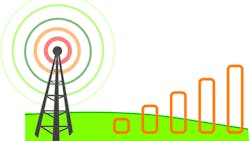Beamforming Technology Embarks on the Next Generation
Beamforming antenna arrays are expected to play a significant role in 5G networks. These antenna arrays allow for increased capacity of cellular networks, as signal-to-interference ratio (SIR) can be improved by directly targeting user groups. In the white paper, “Millimeter-Wave Beamforming: Antenna Array Design Choices & Characterization,” Rohde & Schwarz provides an overview of beamforming technology. The white paper then discusses antenna array simulation techniques, as an antenna array is first simulated with ideal antenna elements and then with actual measured element radiation patterns.
A phase coherent signal is a requirement for all beamforming architectures, as phase coherency can allow a main lobe to be steered in the desired direction. A few methods of generating phase coherent signals are mentioned. Moreover, the document explains how multipath fading and delay spread can significantly reduce a cellular network’s capacity. The white paper states that modern beamforming architectures can help mitigate these problems by adapting to the channel.
Three different beamforming architectures are described. The first one is an analog beamforming transmitter architecture, which consists of an RF chain and multiple phase shifters. Next, the digital beamforming architecture is presented. While analog beamforming is generally restricted to a single RF chain, digital beamforming can theoretically support as many RF chains as there are antenna elements. Lastly, the hybrid beamforming architecture is described. This solution combines advantages of both analog and digital beamforming architectures.
Linear antenna arrays are then theoretically explained. The white paper notes that the radiation pattern of a linear antenna array can be approximated by multiplying the array factor with the element radiation pattern. This element radiation pattern is considered equal for all elements—assuming the array is large enough. Illustrations demonstrate the effect of varying the number of antenna elements, as well as the distance between them. Next, linear antenna array simulations are performed using omnidirectional antenna elements. Simulations are then executed with measured element radiation patterns instead of omnidirectional data to help increase accuracy.
Rohde & Schwarz, Mühldorfstrasse 15, 81671 Munich, Germany; (800) 837-8772

